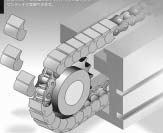Calculation of Chain Stress
On the whole, at first, tentatively determine the chain size to be employed referring to “Tentative determination of chain size”. Then, acquire “Theoretical chain tension (T)” (P213) to the tentatively established chain, and  multiply the worth by “Speed coefficient (K)”, to get “Substantial chain tension (Ta)”. For security, the substantial chain stress should be reduced than the “maximum allowable tension” stated within the table of dimensions of respective chains. Consequently, the issue under must be satisfied.
multiply the worth by “Speed coefficient (K)”, to get “Substantial chain tension (Ta)”. For security, the substantial chain stress should be reduced than the “maximum allowable tension” stated within the table of dimensions of respective chains. Consequently, the issue under must be satisfied.
Safety condition of chain tension
Substantial chain stress (Ta) =Theoretical chain stress (T) ×Speed coefficient (K)
Considerable chain tension (Ta) <Maximum allowable tension
If this affliction is not satisfied, select a larger chain by 1 size and re-calculate.
Tentative determination of chain dimension
qDetermine the mass (excess weight) per unit length of components such as chain and attachment ωc (kg/m or kgf/m) assuming that it really is 10 % from the mass (bodyweight) from the conveyed object ω1 (kg/m or kgf/m).
wIn reference to the calculation formulas on, receive “Theoretical chain stress (T)” (kN or kgf) and “Speed coefficient (K)”, and calculate “Substantial chain stress (Ta)” (kN or kgf).
eIn reference to your table of dimensions of chains,identify the minimal chain, whose “maximum allowable tension” is higher compared to the “Substantial chain stress (Ta)”, and regard it as “tentatively determined chain”.
Value of speed coefficient (K)
The speed coefficient (K) expresses the severity of operation problem according on the traveling speed of chain because the affliction turns into severer since the traveling velocity of chain gets to be larger.
Multiply “Theoretical chain stress (T)” by “Speed coefficient (K)” to acquire “Substantial chain tension (Ta)”.
After you design and style many conveyor systems employing compact conveyor chains, the next standard circumstances has to be happy.
a. Chain tension: The real tensile strength in operation must be considerably decrease than the specified strength in the chain.
b. Strength of loaded elements of chain: The actual loads applied to attachments, this kind of as rollers of base chain, top rollers, side rollers, and so forth. in operation have to be considerably smaller compared to the strength of these elements.
c. Wear daily life of chain: Lubrication circumstances to make certain the wear daily life of chain have to be fulfilled.
d. Sag adjustment of chain: The sag of your chain needs to be kept optimum by tension adjusters, take-up gadgets, guides, etc.
e. Other people: Acceptable measures are taken to prevent rail put on, machine vibration along with other challenges.
The next complement the above.
